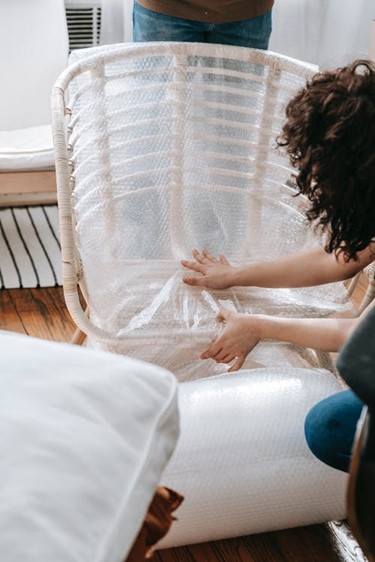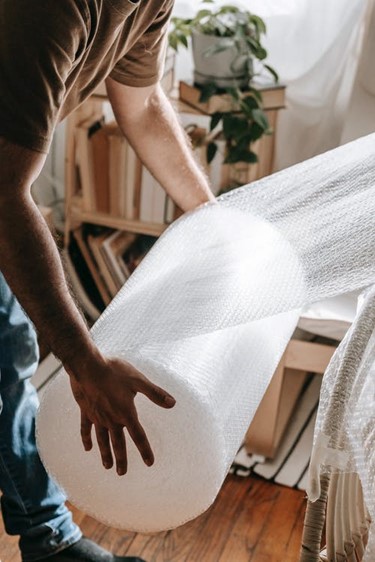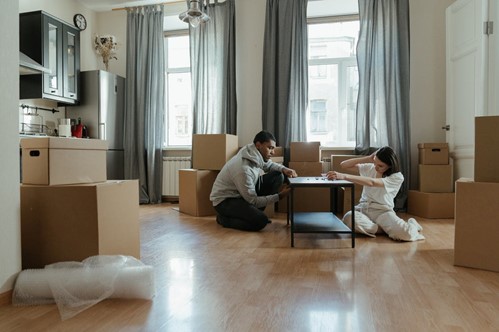Maybe you’re temporarily relocating out of state or permanently relocating across the country, but you haven’t yet located a permanent residence in your new locale. Perhaps you’re downsizing, undergoing a significant renovation, or simply wanting to get seasonal items like patio furniture out of the way. Perhaps you have valuable antiques that don’t fit your home’s décor or high-quality furnishings that you don’t use but wish to pass down to your children.
In all of these situations (and many others), storing your furniture somewhere safe until it is needed again is your best option. All you have to do now is keep an eye on your prized possessions while they’re in storage. The best way to store it is to wrap it up. Never leave furniture unattended in a self-storage unit. Cover the parts with old sheets, blankets, duvet covers, drop cloths, or plastic wrap to keep dust and moisture out. Avoid wrapping furniture in heavy plastic covers that will trap moisture since this can produce condensation and cause the furniture to expand. Wrap furniture in material that is lightly draped over it to allow it to breathe.
Of course, boxes are the ideal choice for security and organization. If it can fit in one, we recommend doing so. A larger item can be dismantled to fit into a box or numerous boxes. We recommend using boxes wherever possible because this is usually the safest place for any item. However, make sure to fully seal your box, taping any openings shut to keep dust and grime out while also strengthening the box’s supports.
Examine your storage choices
Choosing to store furniture might be a pricey option. Do you plan to keep it for the long haul, or do you sell it and replace it when the time comes? The average cost of a storage facility varies, but if you’re in the middle of relocation or going through a transitional period, storing furniture makes sense in many circumstances.
When it comes to keeping furniture, weather protection is essential. Before you choose a storage place, think about all of your possibilities. If you intend to keep this furniture in storage for an extended period, you may want to consider a climate-controlled storage facility.
Your costly furniture pieces will be protected from dampness and shifting temperatures. In this unit type, hardwood furniture, instruments, antiques, and sofas with delicate materials would work well.
Even if climate control isn’t an option, there are actions you may take to safeguard your furnishings. It’s critical to keep everything clean, dry, and well-protected.
Everything should be completely cleaned
Never place unclean objects into storage furniture to protect it. Not only will foul odors spread to neighboring units, but cleaning will also reduce the risk of mildew and the amount of dust in your storage area.
Here are some pointers for cleaning storage furniture:
Use mild soap and water to clean wooden or plastic furniture. To protect the existing finish on the wood, use a wood cleaner on wooden furniture, especially antiques.
- Fabric goods, such as couches or seat cushions, should also be cleaned with fabric or upholstery cleaning. Before you start packing anything up, make sure everything is totally dry.
- Using a polishing cloth and metal cleaner, polish any metal sections. This step will assist in removing any existing oxidation and prevent tarnish from forming.

Dismantle everything
Disassemble anything you can before relocating furniture from its original position, including desks, bookshelves, tables, chairs, and more. This extra step will make packing your truck and, later, your self-storage facility a lot easier. It also reduces the chances of breaking or scratching something.
Place all screws, bolts, Allen wrenches, and other small items in a labeled bag that will be kept with the furniture piece it belongs to.
Raise any furniture that is on the floor
Avoid keeping furniture or anything that could be ruined directly on the floor while storing furniture without climate control. You can add an extra layer of flood protection by raising the floor with pallets or cinder blocks. Anything is better than nothing, so even a layer of cardboard or drop cloth will suffice.
Don’t cram much into your storage space
Overcrowding a storage container is the worst way to store furniture. Overcrowding your personal storage unit is a definite way to break something precious. Please take a few minutes to organize your storage container to make it more accessible. Pack furniture in a methodical manner, beginning with the bigger pieces and working your way down to boxes and tiny stuff.
Make sure you have access to the back and sides of your unit at all times. To protect your furniture and other belongings, keep your storage room clean and decluttered. You risk knocking things over, bending components, and causing other damage as you try to squeeze in more and more stuff.
Furniture can last for decades in the right environment, but if stored improperly, even for a short time, it can succumb to humidity, temperature fluctuations, or physical damage. Naturally, while storing furniture for an extended period of time, the risk of damage is significantly higher, and particular precautions must be taken to protect the safety of your prized possessions.
Maybe you’re temporarily relocating out of state or permanently relocating across the country, but you haven’t yet located a permanent residence in your new locale. Perhaps you’re downsizing, undergoing a significant renovation, or simply wanting to get seasonal items like patio furniture out of the way. Perhaps you have valuable antiques that don’t fit your home’s décor or high-quality furnishings that you don’t use but wish to pass down to your children.
In all of these situations (and many others), storing your furniture somewhere safe until it is needed again is your best option. All you have to do now is keep an eye on your prized possessions while they’re in storage. The best way to store it is to wrap it up. Never leave furniture unattended in a self-storage unit. Cover the parts with old sheets, blankets, duvet covers, drop cloths, or plastic wrap to keep dust and moisture out. Avoid wrapping furniture in heavy plastic covers that will trap moisture since this can produce condensation and cause the furniture to expand. Wrap furniture in material that is lightly draped over it to allow it to breathe.
Of course, boxes are the ideal choice for security and organization. If it can fit in one, we recommend doing so. A larger item can be dismantled to fit into a box or numerous boxes. We recommend using boxes wherever possible because this is usually the safest place for any item. However, make sure to fully seal your box, taping any openings shut to keep dust and grime out while also strengthening the box’s supports.

Examine your storage choices
Choosing to store furniture might be a pricey option. Do you plan to keep it for the long haul, or do you sell it and replace it when the time comes? The average cost of a storage facility varies, but if you’re in the middle of relocation or going through a transitional period, storing furniture makes sense in many circumstances.
When it comes to keeping furniture, weather protection is essential. Before you choose a storage place, think about all of your possibilities. If you intend to keep this furniture in storage for an extended period, you may want to consider a climate-controlled storage facility.
Your costly furniture pieces will be protected from dampness and shifting temperatures. In this unit type, hardwood furniture, instruments, antiques, and sofas with delicate materials would work well.
Even if climate control isn’t an option, there are actions you may take to safeguard your furnishings. It’s critical to keep everything clean, dry, and well-protected.
Everything should be completely cleaned
Never place unclean objects into storage furniture to protect it. Not only will foul odors spread to neighboring units, but cleaning will also reduce the risk of mildew and the amount of dust in your storage area.
Here are some pointers for cleaning storage furniture:
Use mild soap and water to clean wooden or plastic furniture. To protect the existing finish on the wood, use a wood cleaner on wooden furniture, especially antiques.
- Fabric goods, such as couches or seat cushions, should also be cleaned with fabric or upholstery cleaning. Before you start packing anything up, make sure everything is totally dry.
- Using a polishing cloth and metal cleaner, polish any metal sections. This step will assist in removing any existing oxidation and prevent tarnish from forming.
Dismantle everything
Disassemble anything you can before relocating furniture from its original position, including desks, bookshelves, tables, chairs, and more. This extra step will make packing your truck and, later, your self-storage facility a lot easier. It also reduces the chances of breaking or scratching something.
Place all screws, bolts, Allen wrenches, and other small items in a labeled bag that will be kept with the furniture piece it belongs to.
Raise any furniture that is on the floor
Avoid keeping furniture or anything that could be ruined directly on the floor while storing furniture without climate control. You can add an extra layer of flood protection by raising the floor with pallets or cinder blocks. Anything is better than nothing, so even a layer of cardboard or drop cloth will suffice.
Don’t cram much into your storage space
Overcrowding a storage container is the worst way to store furniture. Overcrowding your personal storage unit is a definite way to break something precious. Please take a few minutes to organize your storage container to make it more accessible. Pack furniture in a methodical manner, beginning with the bigger pieces and working your way down to boxes and tiny stuff.
Make sure you have access to the back and sides of your unit at all times. To protect your furniture and other belongings, keep your storage room clean and decluttered. You risk knocking things over, bending components, and causing other damage as you try to squeeze in more and more stuff.
Furniture can last for decades in the right environment, but if stored improperly, even for a short time, it can succumb to humidity, temperature fluctuations, or physical damage. Naturally, while storing furniture for an extended period of time, the risk of damage is significantly higher, and particular precautions must be taken to protect the safety of your prized possessions.

